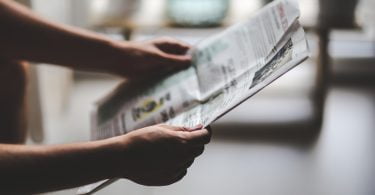Journalism has revolutionised tremendously over the past few years. There was a time when the mere thought of a female journalist evoked shock, surprise and even scorn from the general public. Although women’s voices are gradually being heard in journalism, they are still not as widespread as they should be.
Gender equality in journalism
Today, the move towards gender equality is noticeable but gradual. The Global Media Monitoring Project (GMMP) found that only 32% of hard news stories were either written or covered by female journalists and in 2000 – 2006. It also revealed 57% of news presenters were female but only 29% of all news stories were written by women. A 2011 study found ‘that women made up approximately 28% of those identified as principal staff members at online news outlets included in the Columbia Journalism Review’s database.’
A direct link has been made between the difficulty of raising a family while working in journalism. In the United States, women told researchers that a journalistic career is incompatible with raising a family and that managers frown upon journalists who place family first (Everbach and Flournoy, 2007), while Robinson (2005) found that the majority of female reporters in Canada do not have children, whereas less than a third of male reporters are childless. Ultimately it’s one or the other, you cannot have both.
It’s odd that the media is concerned about a lack of women in top jobs in Corbyn’s Cabinet yet not asking the same questions of journalism.
— Iain (@Cuphook108) September 14, 2015
Do Women get the same opportunity as men in journalism? Just asking. https://t.co/iGUmYiQYoc
— paul henry mortimer (@pmorts) September 7, 2015
But looking at how far women’s influence in journalism has come, many would agree that the last thirty or so years showed growth in the presence and influence of women in the media. This change is an undeniable progress considering only fifty years ago journalism was an almost exclusively male profession. Despite the changes in recent years, the battle for equal rights, paved by the early women of journalism, still has a long distance to reach their goal.
In the late 1800s and early 1900s, journalism was viewed as a ‘man’s job’. They believed it would be too dangerous a job for females, fearing women will be placed in unexpected situations where they will fail to react – at that time, women were viewed as ‘frail little mothers, whose sole purpose in life is to cook, clean and take care of the children’ (The International Federation of Journalists).
But some women thought otherwise. ‘They sought to find and conquer anyone that tried to prevent them from writing’, one of them was Elizabeth Jane Cochran, also known as Nellie Bly.
Nellie Bly
Her daring, courageous efforts named her a great leader in the world of journalism, showing the men of the business she could handle the job just as much as the next man. She is just one of many evidence of the negative attitudes towards women and journalism at that time, as everywhere she went to look for a job, she was met by mocking laughter and cutting words of ‘Go back to the kitchen where you belong’ (Nellie Bly, Biography). So she decided to take matters into her own hands. Fuelled with the anger from the harsh treatments she received from men, she decided to prove them all wrong. She wasn’t just a ‘frail little housewife’ – she was just as brave and willing to venture out into the unknown and find a story.
And a story she did find.

Wikimedia: “Nellie Bly 2” by H. J. Myers, photographer
Feigning insanity, Bly was admitted to New York’s Blackwell’s Island Asylum in one of her daring works titled ‘Ten Days in a Madhouse’ (1888). Through this, she was able to write first-hand accounts of what she had actually seen, experiencing the frontlines in a battle. What she found triggered a chain reaction, not only in the journalism world but also in the field of psychology. Writing about the rat-infested and abusive conditions experienced by the women admitted at the institution, Bly also brought to light the stigma attached to mental illness; how easy it was to be admitted by merely feigning insanity and the difficulty in proving your sanity when both doctors and nurses dismiss your words as the mindless mumblings of the insane. Once released from the asylum, she published these experiences in The New York World, leading to a mass of letters which forced the City of New York to spend $1,000,000 more per annum to care for the insane.
Eleanor Roosevelt
Eleanor Roosevelt is another example. The First Lady started writing a column called ‘My Day’ in 1935; its focus on the concerns of women. By 1939, the topics had expanded from women’s’ issues, to key events such as Pearl Harbour, Hollywood, television, race segregation and the Cold War. These articles not only offered light to issues such gender equality but also racial equality and support for youths – she made sure African Americans were receiving relief from New Deal programs and helped found the National Youth Administration in 1939 which helped thousands of high school and college students find part-time work.

Wikimedia Commons: “Eleanor Roosevelt at United Nations” by US Government
These cases demonstrate the power of words in society – they raise issues and create ideas, spreading like wildfire until actions are taken to bring solutions and positive change.
In the media
On the other side of the spectrum is the controversial portrayal of women in the media and how this influences us and helps in establishing our own beliefs, albeit, demeaning towards women. Constantly objectified and represented as passive, these portrayals of women not only affect a young girl’s perception of herself and the world, but also convey to young boys that women are rewards and objects of their use.
‘The glamorous sex kitten, the sainted mother, the devious witch, the hard-faced corporate and the political climber’ – these are the litany of common images of women in the media as described by a UNESCO report, emphasizing the objectification, sexualisation and stereotyping of women in the media. Released in 2009, this report states that at the current rate of progress in the portrayal of women, it will take another 75 years to achieve gender equality in the media.
Moreover, standards of feminine beauty are constantly presented in almost all forms of media, assaulting women with unrealistic images of what is considered to be the ‘ideal body’.

Pixabay: IgorSaveliev
Numerous studies conducted in many countries have found that nearly three-quarters of women reported negative views on their body image after seeing images of models in magazines and advertisements. With airbrushed images of thin and seemingly perfect models, it is no wonder that this unattainable image of beauty, the social pressure to stay thin and maintain a perfect image has generated an unhealthy environment for young girls in the form of eating disorders.
The National Alliance for the Mentally Ill (2003) showed that although both men and women suffer from eating disorders, women aged between 12 and 25 are the most affected. Anorexia nervosa, an eating disorder characterised by not eating in hope of becoming thin, is a result of a distorted body image. Furthermore, studies indicate that about 50% of those who begin an eating disorder with anorexia nervosa later develop bulimia, another serious eating disorder which involves a destructive pattern of binge-eating and purging.
Standards of beauty are reinforced through commercials of beauty products with thin, flawless women and their bodies and so the public absorb this message – beauty is the norm. Therefore, as humans, we conform. We do not see beyond these media portrayals, how industries maintain profits by exploiting women’s insecurities which, ironically, stems from these very industries and their unrealistic ideals. These media-induced insecurities mean women are more likely to buy beauty products, new clothes and diet aids in an attempt to look like these models. They may even go as far as participating in crash-course diets, no matter how unhealthy and bizarre they appear to be.
The constant portrayal of women’s body’s in the media is a continuation of oppression #EveryGirlsBeautiful #halfthesky pic.twitter.com/GAMLUf8Y
— Michelle Defoe (@MorningStar_kwe) October 3, 2012
The diet industry alone is worth between 40 and 100 billion a year selling products while in a recent study of 10,000 girls aged 8 to 12, 17% induced vomiting or used laxatives and diet pills to lose weight. By the time these girls reach adolescence, eating disorders are the third most common illness afflicting them.
And this does not only occur in Westernised cultures. In South Korea, for example, the growing popularity of the ‘hallyu wave’ (Korean wave) has brought these ideals to shore. With increased exposure to television and the media and to idols with their sculpted faces and perfect choreographies, the public is constantly exposed to idealised beauty of big eyes, pale complexion, a sharp pointed nose and a small chin and jaw. Much evidence indicates that this beauty ideal is not merely a trend, but a very real standard that is growing deeper in the Korean society, to the point where appearance is starting to play a bigger role in the work place. As a result, even high school student graduates undergo plastic surgery as graduation gifts in an attempt to look like their favourite idols, actors and actresses, which can also contribute to the high diagnosis of depression in the general Korean public.

Flickr: Republic of Korea
However, it is not only eating disorders that plague women exposed to these warped ideals. Poor body image can also lead to depression and anxiety; bombarded with impossible images of extreme ideals, any individual’s psyche will take a beating with the worry of living up and conforming to what they believe is expected of them – what they believe society expects of them.
By having more women in the world of media and journalism, these issues about gender and self-image may be addressed. There is no argument that women are not capable of handling harsh situations; that they would buckle beneath the subject of war or politics or crime. Female journalists such as Nellie Bly and even the former First Lady, Eleanor Roosevelt are proof that women are just as capable as men.
Although this is not to say that all journalists should be women, the argument stands that there should more gender equality present in the media. Men and women perceive things differently. What men see may not necessarily be what women see. Like pieces of a puzzle, each perspective is equally important and disregarding one means part of our society is placed under darkness, less noticed and obscured – without a balance, without equilibrium, this puzzle will not be complete.
Are you a women working in journalism? Have you found your ideas slighted by male colleagues? Or have you experienced the opposite? Leave your comments below!









